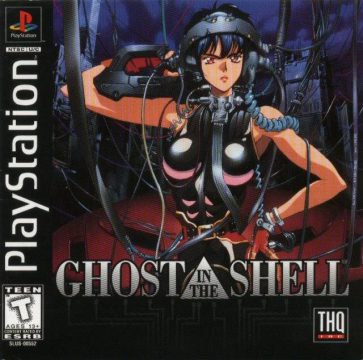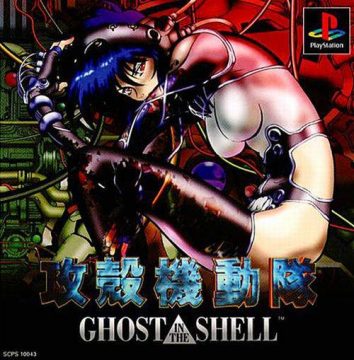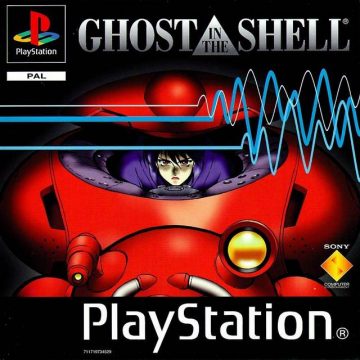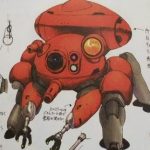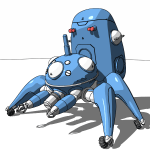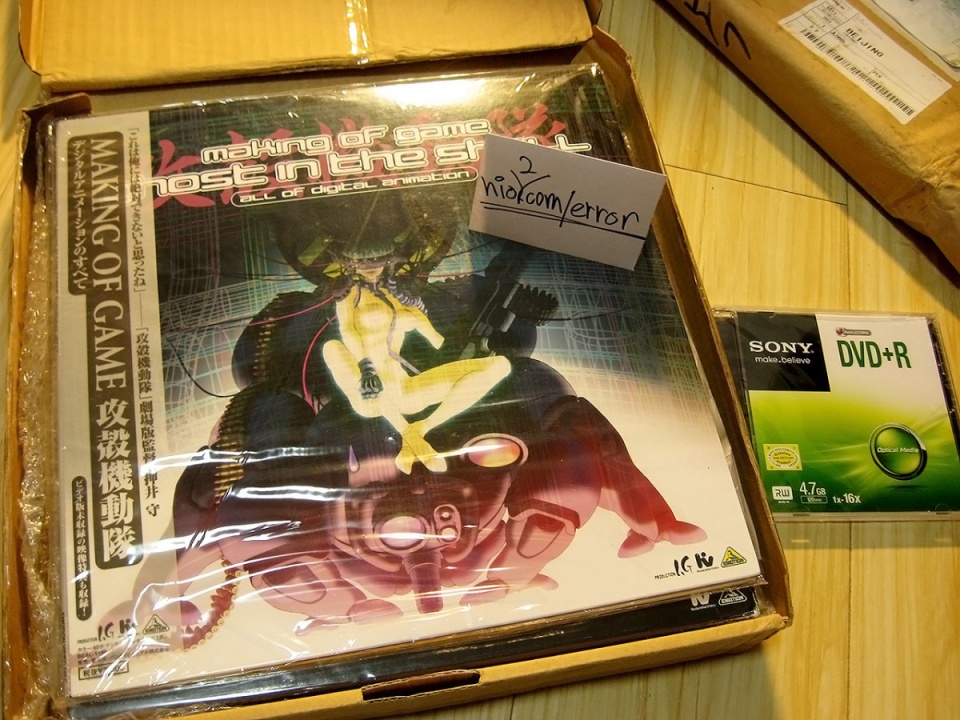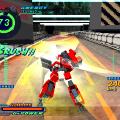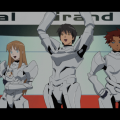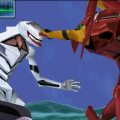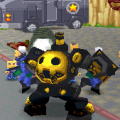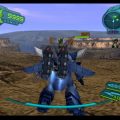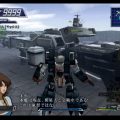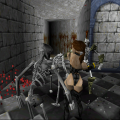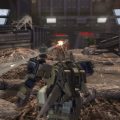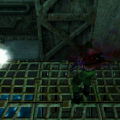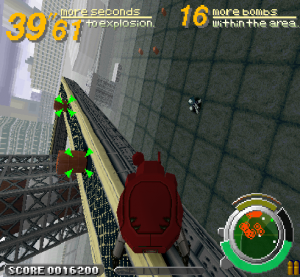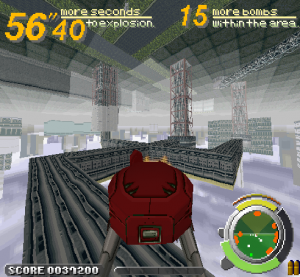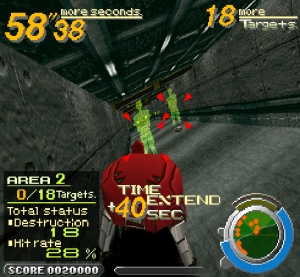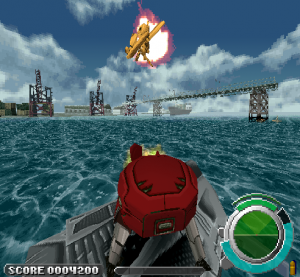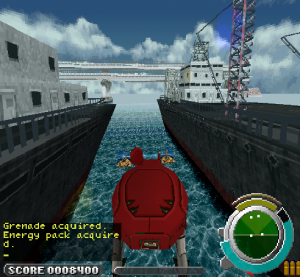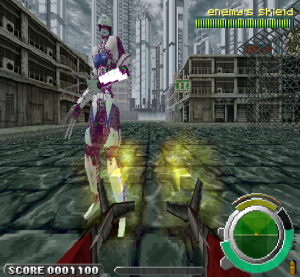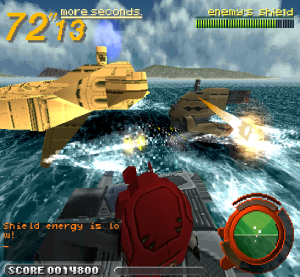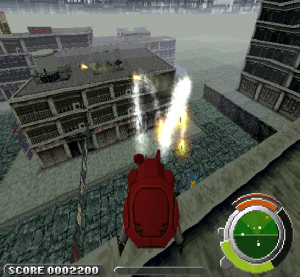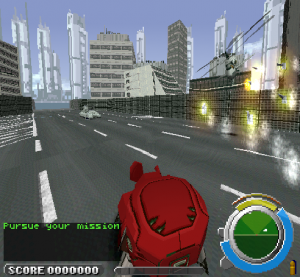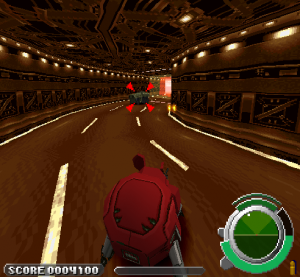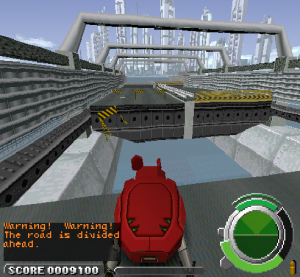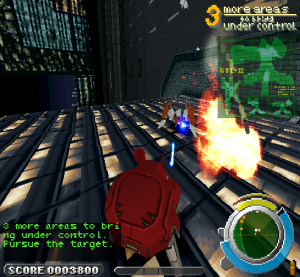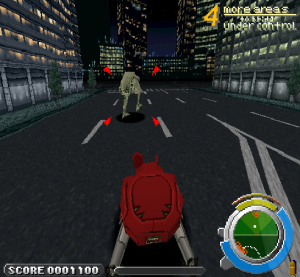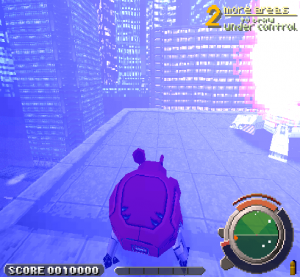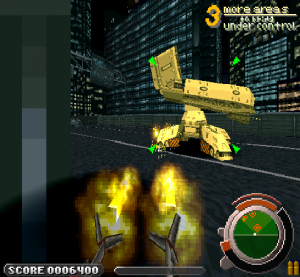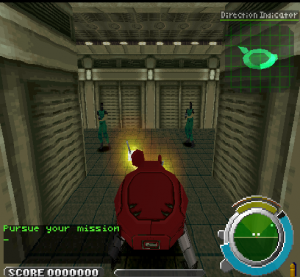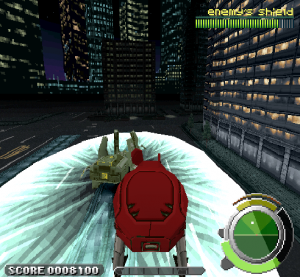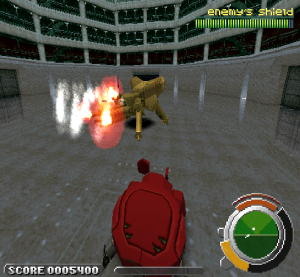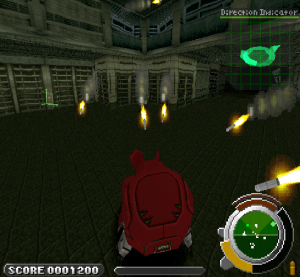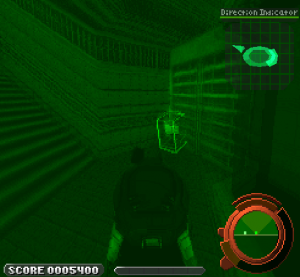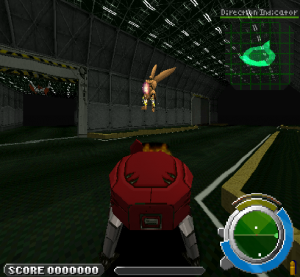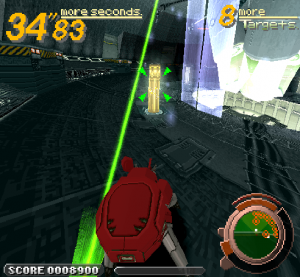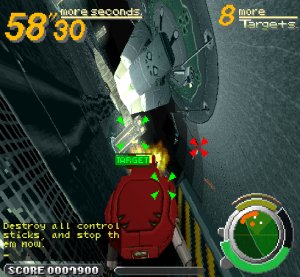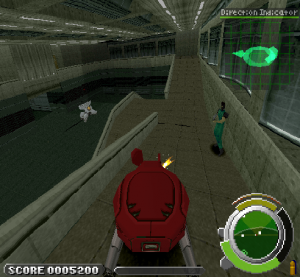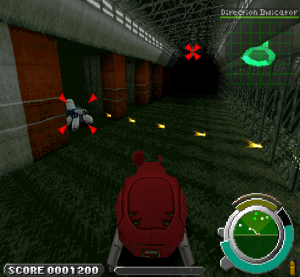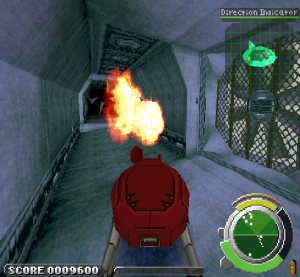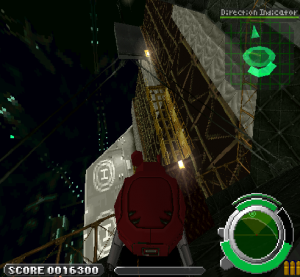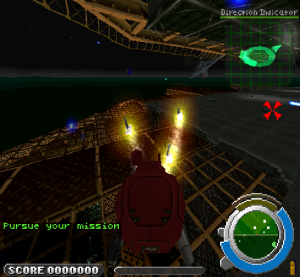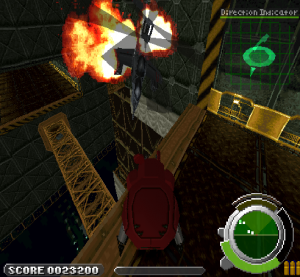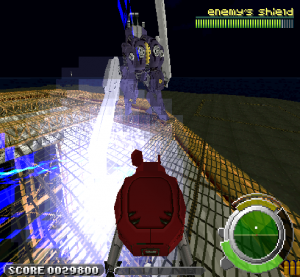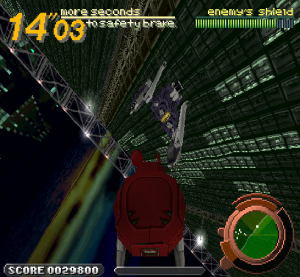Masamune Shirow, real name apparently Masanori Ota, needs little introduction. As the creative mind behind the phenomenally popular manga series of Appleseed (1985), Dominion: Tank Police (1986) and Ghost in the Shell(1989), all of which received anime adaptations in some form, almost everyone who plays video games is likely to have experienced his work, or a derivative thereof. After all, there has always been overlap between the world of manga, anime and video games, and it’s impossible to partake in one without some influence from the others. He’s also been directly involved with some original video games, such as Fire Emblem and the Horned Owl series. The particularly adventurous may have even partook of Shirow’s erotic art books, produced later in his career, with images of shiny lithe women ranging from the exquisite to the downright disturbing.
There doesn’t seem to have been any proper videogame adaptations of Dominion: Tank Police, whereas Appleseed received a couple of Japan exclusive titles, including one on PS2. Ghost in the Shell however received plenty of games, which isn’t really surprising given its cyberpunk theme. As a creative work it’s perfectly suited to the world of videogames. Set variously around the year 2030, the overall theme of Ghost in the Shell is of humans integrating further and further with machines, with people choosing to be “cyberized” – that is, having their brain augmented to interface directly with computers, even having portions of it replaced with nanomachine electronics. It even gets philosophical in places, questioning the nature of being human. Of course with this rise in technology, so too is there a rise in technology based crime, with people’s cyberbrains being “ghost hacked”, or taken over. This is where Public Security Section 9 comes in, dealing with hackers and “cyber terrorists”. The group is comprised of an eclectic mix of characters, with various degrees of augmentation.
Characters

Major Motoko Kusanagi
The lead heroine of the Ghost in the Shell world and in command of Section 9, the Major’s background is shrouded in secrecy. As a cyborg she’s the most synthetically augmented in Section 9 along with Batou; her entire body is synthetic, apart from her brain. She has a good relationship with Batou, making jovial banter on occasion in the games. Kusanagi is a playable character in both SAC titles on PS2 and PSP.

Batou
Second in command after Kusanagi. He’s also had much of his body augmented, including having his eyes replaced. Although he looks like a tough guy, he’s a bit of a softy at heart, doting on his Fuchikoma / Tachikoma. Batou is playable in both SACtitles on PS2 and PSP. On PS2 his levels take a more standard action-shoote approach to Kusanagi’s nimble platform leaping, while on PSP he has more health.

Togusa
The family man of the unit, Togusa is almost entirely human, only with a cyberbrain enhancement. He’s an ex-cop, rather than ex-military like the others, and so catches a bit of flak for it. In the games he’s generally more laid back than the other characters. On PS2 he provides a support role, while on PSP he’s playable and has a slightly faster movement speed.
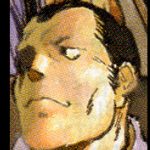
Saito
More prominent in the manga and anime than the games, Saito is the chief sniper of Section 9. His left arm is cybernetic, while his left eye was replaced with a “Hawkeye” allowing him to connect to satellites for precise aiming. He doesn’t seem to turn up in the PS1 game, plays a support role on PS2, but is playable on PSP. Unfortunately he doesn’t seem to offer any advantage over the others when using sniper weapons.
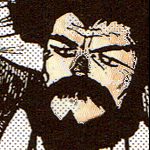
Ishikawa
The background guy who deals with incoming data, Ishikawa will crack open and decrypt files found out in the field, then relay the information back to the team. Prominent during cut-scenes on PS1, he also shows up to offer background support on PS2 and PSP.

Chief Aramaki
An old man with a wild hair style, he is the least cyberised along with Togusa. Quite strict, he’s also honourable and keen to ensure the well being of his crew. Usually he oversees operations from headquarters, offering support (or barking orders) on PS1 and PS2, but in the PSP game he takes an active part in a couple of missions, requiring an escort. He’s also playable in multiplayer.
The Think Tanks
Fuchikoma
You never saw these guys in the film, did you? That’s because they’re mainly in the manga, which makes the PS1 game (which has them in the starring role) more of a manga adaptation than film adaptation. Although AI controlled robots, the Fuchikoma have enough personality to warrant their own profile box. Generally they behave like heavily armed children, curious about the world and with cute personalities, but also deadly. Able to operate interpedently, members of Section 9 can ride around while inside their abdomen. They’re able to use optic camouflage to go invisible, and can walk around on walls. Referred to as “think tanks”.
Tachikoma
These guys are only found in the Stand Alone Complex spin-off. Allegedly the original Fuchikoma design couldn’t be used due to legal copyright issues, so Masamune Shirow drew an entirely new model, inspired by the originals. Despite trawling the internet, the only source for this fact is this fansite. The actual design is more cuboid and ugly compared to before, but their personalities are as adorable as ever. They also feature more strongly in the overall narrative. There’s only one level in the PS2 game where you control a Tachikoma, but you can’t make it walk on walls. In the PSP game you constantly have one as an assistant and can ride around inside it when you choose.
The franchise overall is huge. There were three manga volumes of the original series by Shirow, followed by two film adaptations of these volumes by Mamoru Oshii, who gamers may recognise as the guy behind the shockingly dreadful Sky Crawlers film, which itself became a videogame. Here things become a little confusing, as the original GitS manga/anime spawned a kind of spin-off TV series, titled Ghost in the Shell: Stand Alone Complex. It re-uses the same main characters, and is set in roughly the same world, but in some kind of alternate storyline universe. For starters, the Fuchikoma robots from before are replaced with entirely redesigned Tachikoma. SAC was expanded into a follow-up series and a third feature film, not directly related to the previous two films.
The non-game related side gets really complicated really fast, with a myriad of art books, soundtracks, toys, DVD releases, an OVA adaptation, remakes and innumerable re-releases of various materials in slightly tweaked forms. The games meanwhile are based on both the original GitS and its alternative universe SAC spin-off, and they come with their own related tidal wave of merchandise. In a situation similar to the Zenki series, the games are wildly eclectic, obfuscated by a complex licensing hierarchy. For consoles, three different developers produced three different games for three different systems in three distinct styles/genres. Additionally there are at least three Japan-exclusive mobile phone games we know of, by two different developers, plus at least two distinct pachinko/pachislot machines by two different companies. Recently there was also the announcement of an unnamed game (presumably an MMO) in the works. And all this doesn’t even touch upon the many publisher and outsource names which grace the splash screens for all of the above.
Don’t let this quagmire of disparity dissuade you though. All you need to keep in mind is that the three main GitS releases are comparatively inexpensive, fairly easy to find, and all three are varying degrees of high excellence.
Developed by Exact, famous for the Jumping Flash series, the first Ghost in the Shell game was released two years after the first film adaptation and nearly a decade after the original manga began serialisation. Exact were assisted by Production IG, a prominent anime studio responsible for the first film, which would go on to develop all further animated GitS material, including the Stand Alone Complex spin-off series years later. This really shows, since the claimed 10 minutes of hand-drawn FMV in the game is top quality, despite some graininess due to compression. Although released two years after the film adaptation, and using animation by the same studio that produced it, the original PlayStation game is actually more closely based on the original manga series rather than the film that came from it. The most obvious thing is that you pilot a Fuchikoma “think tank”, which were seemingly absent from the film.
The story itself is a fun little self-contained “gaiden”, meaning if you have no prior experience to the franchise it doesn’t really matter. Players take control of a faceless, nameless rookie, whose only backstory is detailed in the manual. A new member of Section 9, having been recruited from the police force, his first real missions are the 12 which take place over the course of the game and are divided between chapters. A group calling themselves the Human Liberation Front has claimed responsibility for blowing up the Megatech corporation’s building, and Section 9 need to solve the case. As you’d expect from the series there’s a fair amount of technical dialogue, with some interesting twists towards the end.
Each of the 12 missions is preceded by a briefing and 3D map screen, where members of Section 9 are each assigned a task, including the rookie, whereas the start of each chapter features an FMV cut-scene. The acting throughout is superb and easily qualifies as some of the best for the generation, which is no surprise given that it was handled by the company that produced the film. The same actors, such as Mimi Woods (Kusanagi), also reprise their roles. At least for the English release – the German dub is reported to be terrible. The script is well written, and the dialogue extremely witty; Togusa’s complaint about the speed read-out being in miles rather than kilometres is priceless. Characterisation for all the main characters is well done, including the Fuchikoma who have a personality all of their own. “Look, the rookie gave me these little stickers!” says one, pointing to a sticker on his forehead, typically used by learner drivers in Japan, resulting in a rebuke from Bato. There’s some animosity among gamers that the onset of the CD medium, popularised by the PS1, was the beginning of long-winded and boring cut-scenes, poorly voiced dialogue, and pointless narrative filler. If the cut-scenes and dialogue in every game were of similar quality to GitS, no one would have any complaints. Not only does it encourage you to play further, but by the end you really wish there was more of it. GitS stands as a near perfect example of how to integrate FMV and dialogue with intense and tightly refined gameplay mechanics. For example: as an explosive boss battle against a nuclear reactor finishes, an FMV showing the exact same room starts up, with empty bullet casings littering the floor. It’s immersive and it works well.
Although it’s easy to dwell on the game’s high quality anime trappings, this would be a disservice to the game itself – which is not only genuinely unique in its premise and execution, but also to this day stands as one of the best 3D action platformers of the era. This may sound like hyperbole, since every website seems to tout something or other as “the best”, and in contrast the majority of review scores from the time were in the 7/10 range. If you ask around, however, those who’ve played it will attest both to its quality and the fact that it has aged better than the majority of 3D games on 32-bit hardware.
It’s basically an arcade-style shooter with fairly simple controls: you move, jump, strafe, and launch power bombs (holding up to a maximum of three), plus fire machineguns by tapping shoot, or holding shoot to charge up to six lock-on missiles which are infinite in supply. All very conventional. What makes it unlike anything else is that you can walk on any flat surface, at any time, for as long as you like. Well, not every surface, just things that could realistically hold your weight. So chain-link fences are out of the question, as are a few other anomalous objects, such as small vehicles or anything with a peculiar shape. But generally you can say: everything. Which sounds like such an obvious idea for a great game, but think back to 1997 – how many other games allowed it? And those that did, was it all the time, or only as a temporary gimmick? Toy Commander for the Dreamcast, released years afterwards, allowed you to roam around the walls of a house, but only in certain vehicles and only when ramps permitted it. Looking at the TV Tropes page on the subject, few games utilise such an idea, and when they do it’s often in a limited capacity so as not to “break” the game. GitS in contrast is built specifically around the ability to walk on any surface, during all but two missions, with the level design reflecting this in intelligent ways.
Due to being developed by Exact it often gets compared to Jumping Flash, especially since they both apparently use the same bespoke 3D engine. The comparisons are overplayed, however, since GitS has almost nothing in common, either stylistically or mechanically. In Jumping Flash you make enormous vertical leaps, almost into the clouds, followed by a slow fall downwards. GitS is actually closer to the PC game Descent (1994), which was ported to PS1, albeit with gravity and your “vehicle” instantly snapping to the ground if you push jump while upside down. Significantly, the camera is locked to the player’s Fuchikoma, rather than where the ground is, allowing for epic, vertigo inducing camera shots. Contrary to how it may sound, it’s not actually disorientating when attaching to surfaces, which happens seamlessly. You can walk directly onto walls and ceilings as a spider would, or jump directly onto or between vertical surfaces, such as the sides of two buildings. Only if detaching suddenly while upside down you might lose your orientation, but the radar helps with getting re-aligned quickly. There is complete freedom of access and movement.
There’s also plenty of variety over the 12 missions (plus a 13th “training mission”). Missions 1, 3-7 and 12 are outdoors, while missions 2 and 8-11 are indoors, and each has differing objectives. The first is a leisurely hunting down of four enemies with keycodes, the third a tense bomb defusing run with some high altitude climbs. Missions 4 and 6 are high speed “chase stages”, taking place on the open waters and then city highway. For the fifth stage you’re tracking a powerful cloaked enemy through the slums, Predator-style. Mission 7 is one of the best, as you roam the city at night taking out four enemy gun emplacements, leaping between tall buildings like a mechanical Spiderman. Missions 8-11 are a low point – not because they’re bad levels, but they’re all indoors and can feel a little similar. It makes sense within the context of the story, but four mostly similar levels all on the trot does lose that sense of surprise slightly. Still, there’s an epic boss battle against a nuclear reactor with automated defences at one point, which is awesome.
The final mission is the best in the game, and showcases everything that makes GitS such an amazing title. You need to reach the top of a building which is still under construction, and so have to crawl along walls, ceilings and over girders, taking out enemies and mines from all angles, while being careful to avoid falling to your death. Since the Fuchikoma naturally clings to any flat surface it’s not that difficult, but those with a fear of heights need not apply! Even with the knowledge that you can safely hang upside down indefinitely, seeing a Jigabachi attack chopper, which itself appears upside down from your perspective, can make you a little dizzy. It’s an amazing feeling, which not a lot of games before or since have captured.
It’s also a tough little game in places! Expect to die a few times while playing through it. There’s no difficulty select, but it’s pitched just right to offer a surmountable challenge during the stages themselves. Most deaths are due to misjudging the enemy’s attack pattern or, in the case of the chase stages, poor maneuvering through new areas. Technically you only get one life – or unlimited lives, depending on how you look at it. Die and you’re returned to the title screen, but after a level has been reached once it can be reloaded at any time, meaning you can immediately restart where you left off. In this way the game ends up being quite easy since restarting is painless. It also has just the right balance of exploration, at least for the outdoor levels. They’re expansive but contained within a square area, and the radar always points you in the direction of targets, so you never get lost.
Facilitating these levels is an extremely robust 3D engine, one which is still impressive despite the game’s 15 year age. It’s ironic that despite popularizing 3D visuals, to the detriment and near extinction of 2D, the majority of PS1 games are now ugly and near-unplayable, with poorly functioning cameras and stodgy controls. It’s actually the system’s 2D library which has aged the best. Despite this, GitS is one of the few 3D games that still works. Although it touts analogue stick support, you don’t really need it and the digital d-pad is perfectly sufficient. The right stick isn’t used since the camera is always locked to the Fuchikoma, making for extremely tight controls by strafing with L/R and aiming left and right with the left stick or d-pad. For those accustomed to direct camera control this might seem archaic, but the game really wouldn’t work as well any other way. It can actually even be played like a pure FPS by hitting select for a camera change. They say Japan can’t do the FPS genre, but here’s a perfectly fine console example dating back to 1997. The rigid camera is essential to making you feel directly in control, especially when crawling over surfaces.
Conveying a futuristic world of straight lines, manmade structures and cyborgs also lends itself to the PS1’s limited polygon models. There’s no foliage, no trees, in fact absolutely nothing organic to betray the hardware’s cuboid limitations. Even the humanoid enemies are described in the manual as being “machine dolls”. There’s some background foliage seen through a window in one stage, but it’s barely noticeable. Apart from the grainy textures you’d expect from the 32-bit era, and a slightly visible draw distance when up high, you could argue the game almost has a timeless visual aesthetic. How many other Saturn or PS1 games can say this? Bulk Slash on the Saturn pushed the hardware like few other games, and is extremely colorful, but the 3D is ugly. GitS is right up there with Omega Boost on the PS1.
The audio also deserves praise, with a decent techno soundtrack by known artists (with more than one OST release). The sound effects, something which is usually overlooked by critics, also indicate how expertly crafted the game is. Charging your lock-on missiles comes with two sounds: one sound for the charger itself, which goes up and then depletes to cancel out, and a second sound for each lock-on, with almost a musical tone to it. There’s a bar at the bottom of the screen to show this information visually, but when you’re in an intense gunfight the sound effects alone allow you to lock-on precisely even while focusing on something else. It’s a small, perhaps insignificant thing, but it’s nice to find and does help give you an edge during play.
The only legitimate complaint is the short length – which may seem like masked praise, and to an extent it is. But in Europe the game can sell for high prices, which given the playtime of a couple of hours is a little steep. There also isn’t much of an incentive to replay the game, since there’s no difficulty select, no items to collect, and nothing to unlock. The inclusion of which, ironically, is a complaint raised against other more bloated games. GitS has a laser-like focus with zero padding or superfluous additions. Regarding unlockables the exception is the training mission, since there are 10 cinemas to unlock depending on your performance, but even this won’t take more than half an hour tops. Some critics complained about boss repetition, but this is nonsense. There are five styles of boss: fixed, roaming and chase stage, plus mission 2, where it’s stuck at the end of a tunnel and always in view, and mission 5 where you systematically hunt it through a city. They all look different, and each has a slightly different attack pattern. There’s plenty of variety in them.
Given the nature of the license, especially with the subsequent spawning of Stand Alone Complex, the original PlayStation version of Ghost in the Shell will never be re-released. The only way to experience it is to acquire the original. Everyone who can play PS1 games and likes action titles should play it.
Merchandise
There was a whole slew of merchandising related to the first game. The most interesting of which is probably the “Making of Game Ghost in the Shell Digital Animation Video” on VHS cassette, all 30 minutes of it. Wikipedia stupidly tries to claim this is a book, despite having video in the title, and most sources for it online showing it’s quite clearly a VHS cassette. It’s available for about 300 Yen on Amazon if you’re able to purchase from there. Given the title one would hope it goes in depth on how the game itself was structured, though this isn’t quite the case. As described by the owner of the Megatech Body Ltd blog: “The video is basically about the creation of the animated scenes. It does get into game development a bit but not much. I think it’s a fantastic video though, the only downside is it’s in full Japanese.” Since getting in contact, the owner has kindly uploaded the video to Youtube. According to a Japanese blog, there also appears to have been some kind of laserdisc relating to this video.
For something a little more accessible on the game’s creation, the Official Art Book is a good investment. It contains innumerable drawings which were used when creating the game’s polygon models and FVM cut-scenes, and shows them alongside the equivalent shots from the game. It’s almost a design document, and is absolutely beautiful on coffee tables. It’s quite rare and expensive though, so in the interests of try before you buy, check out Flying Full Force.
There were also two guidebooks released, one titled Basic File the other Master File, implying different degrees of comprehensiveness. It’s strange though, since the game is so short and so straightforward, there’s absolutely no need for one strategy guide, let alone two! These are even more rare than the art book, but HERE is a mini-gallery with a batch of photos nabbed from an eBay auction. They re-use a lot of artwork from the art book, and it’s incredible to think they actually bothered to create maps for all the levels. It would probably take more time to read the guides than just play the game!
Finally there were the usual OST releases, including two on vinyl record. The aforementioned Megatech Body Ltd blog has all manner of information, hi-res imagery and downloads of these.
Special thanks to Corsair and Roushimsx on the HG101 forums for scanning various materials.

